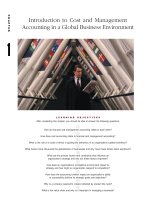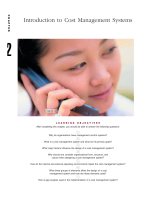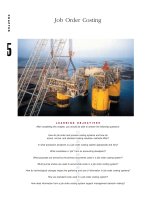Cost accounting chapter 17
Bạn đang xem bản rút gọn của tài liệu. Xem và tải ngay bản đầy đủ của tài liệu tại đây (1.67 MB, 30 trang )
Process Costing
© 2009 Pearson Prentice Hall. All rights reserved.
Job-Costing Systems
Distinct, identifiable
units of a product
or service
Examples:
Custom-made
machines,
Houses
Process-Costing
Systems
Masses of identical
or similar units of a
product or service
Examples:
Food,
Chemical processing
© 2009 Pearson Prentice Hall. All rights reserved.
Process-Costing
Process-costing is a system where the unit
cost of a product or service is obtained by
assigning total costs to many identical or
similar units
Each unit receives the same or similar
amounts of direct materials costs, direct
labor costs, and manufacturing overhead
Unit costs are computed by dividing total
costs incurred by the number of units of
output from the production process
© 2009 Pearson Prentice Hall. All rights reserved.
Process-Costing Assumptions
Direct Materials are added at the beginning of
the production process, or at the start of work
in a subsequent department down the
assembly line
Conversion Costs are added equally along the
production process
© 2009 Pearson Prentice Hall. All rights reserved.
Five-Step Process-Costing Allocation
1. Summarize the flow of physical units of
2.
3.
4.
5.
output
Compute output in terms of equivalent units
Compute cost per equivalent unit
Summarize total costs to account for
Assign total costs to units completed and to
units in ending Work-in-Process
© 2009 Pearson Prentice Hall. All rights reserved.
Equivalent Units
A derived amount of output units that:
1. Takes the quantity of each input in units
completed and in unfinished units of work in
process and
2. converts the quantity of input into the
amount of completed output units that could
be produced with that quantity of input
Are calculated separately for each input
(direct materials and conversion cost)
© 2009 Pearson Prentice Hall. All rights reserved.
Steps 1 & 2 Illustrated
© 2009 Pearson Prentice Hall. All rights reserved.
Steps 3, 4 & 5, Illustrated
© 2009 Pearson Prentice Hall. All rights reserved.
General Ledger Cost Flows
Illustrated
© 2009 Pearson Prentice Hall. All rights reserved.
Weighted-Average
Process-Costing Method
Calculates cost per equivalent unit of all work
done to date (regardless of the accounting
period in which it was done)
Assigns this cost to equivalent units
completed & transferred out of the process,
and to incomplete units in still in-process
© 2009 Pearson Prentice Hall. All rights reserved.
Weighted-Average
Process-Costing Method
Weighted-average costs is the total of all
costs in the Work-in-Process Account divided
by the total equivalent units of work done to
date
The beginning balance of the Work-in-Process
account (work done in a prior period) is
blended in with current period costs
© 2009 Pearson Prentice Hall. All rights reserved.
Steps 1 & 2 Illustrated
© 2009 Pearson Prentice Hall. All rights reserved.
Steps 3, 4 & 5 Illustrated
© 2009 Pearson Prentice Hall. All rights reserved.
Result of the Process
Two critical figures arise out of Step Five of
the cost allocation process:
1. The amount of the Journal Entry transferring
the allocated cost of units completed and
sent from Work-in-Process Inventory to
Finished Goods Inventory
2. The ending balance of the Work-in-Process
Inventory account that will appear on the
Balance Sheet
© 2009 Pearson Prentice Hall. All rights reserved.
First-in, First-Out
Process-Costing Method
Assigns the cost of the previous accounting
period’s equivalent units in beginning workin-process inventory to the first units
completed and transferred out of the
process
Assigns the cost of equivalent units worked
on during the current period first to
complete beginning inventory, next to stat
and complete new units, and lastly to units
in ending work-in-process inventory
© 2009 Pearson Prentice Hall. All rights reserved.
First-in, First-Out
Process-Costing Method
The beginning balance of the Work-in-Process
account (work done in a prior period) is kept
separate from current period costs
© 2009 Pearson Prentice Hall. All rights reserved.
Steps 1 & 2, Illustrated
© 2009 Pearson Prentice Hall. All rights reserved.
Steps 3, 4 & 5, Illustrated
© 2009 Pearson Prentice Hall. All rights reserved.
Result of the Process (as before)
Two critical figures arise out of Step Five of
the cost allocation process:
1. The amount of the Journal Entry transferring
the allocated cost of units completed and
sent from Work-in-Process Inventory to
Finished Goods Inventory
2. The ending balance of the Work-in-Process
Inventory account that will appear on the
Balance Sheet
© 2009 Pearson Prentice Hall. All rights reserved.
Standard Costing and
Process Costing
Teams of design and process engineers,
operations personnel, and management
accountants work together to determine
separate standard costs per equivalent unit
on the basis of different technical processing
specifications for each product
Standard costs replace actual costs in
equivalent unit calculations
© 2009 Pearson Prentice Hall. All rights reserved.
Steps 1 & 2, Illustrated
© 2009 Pearson Prentice Hall. All rights reserved.
Steps 3, 4 & 5, Illustrated
© 2009 Pearson Prentice Hall. All rights reserved.
General Ledger Cost Flows Illustrated
© 2009 Pearson Prentice Hall. All rights reserved.
Transferred-in Costs
Are costs incurred in previous departments
that are carried forward as the products cost
when it moves to a subsequent process in the
production cycle
Also called Previous Department Costs
Journal entries are made to mirror the
progress in production from department to
department
Transferred-in costs are treated as if they are
a separate type of direct material added at
the beginning of the process
© 2009 Pearson Prentice Hall. All rights reserved.
Steps 1 & 2, Illustrated
© 2009 Pearson Prentice Hall. All rights reserved.









